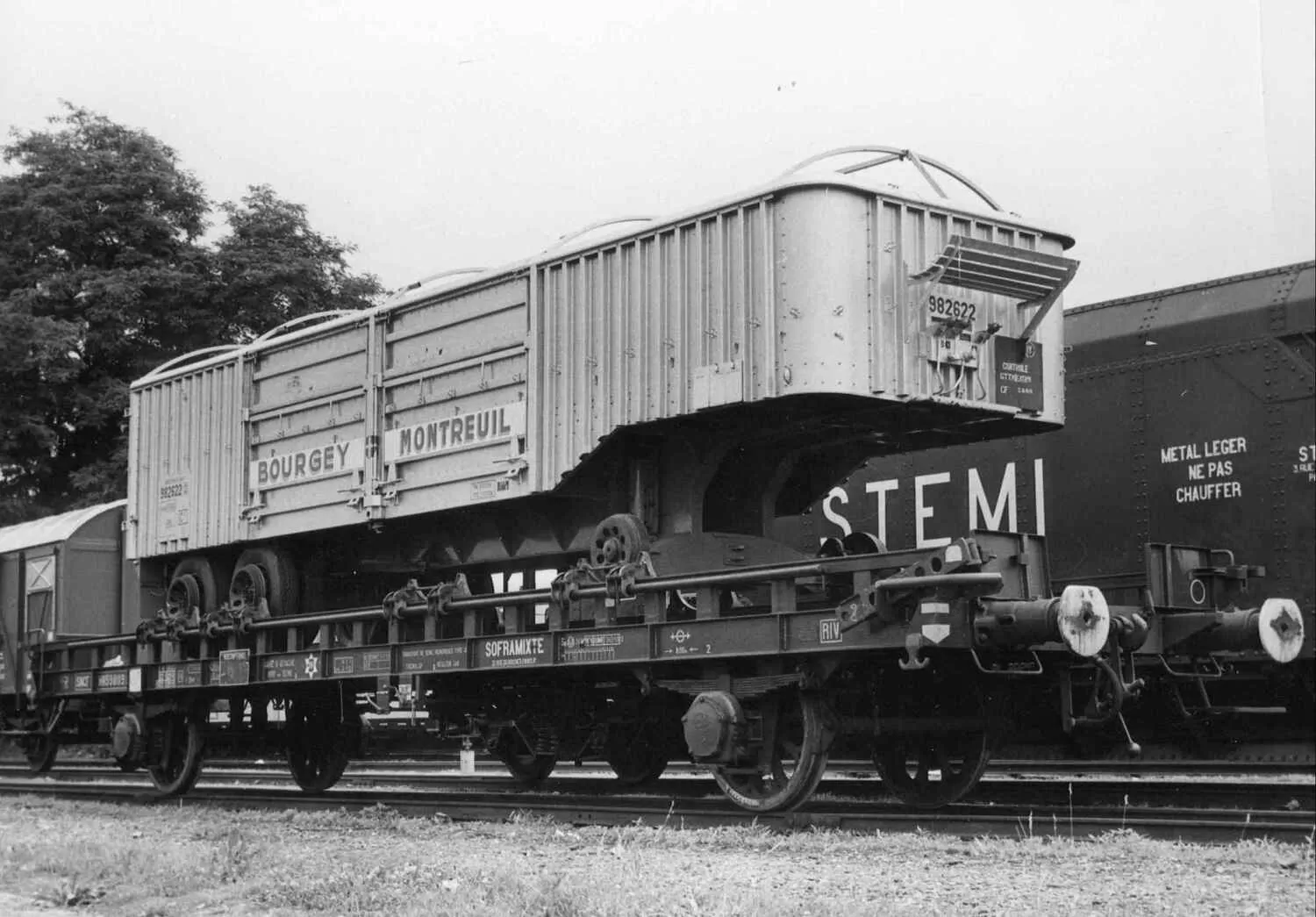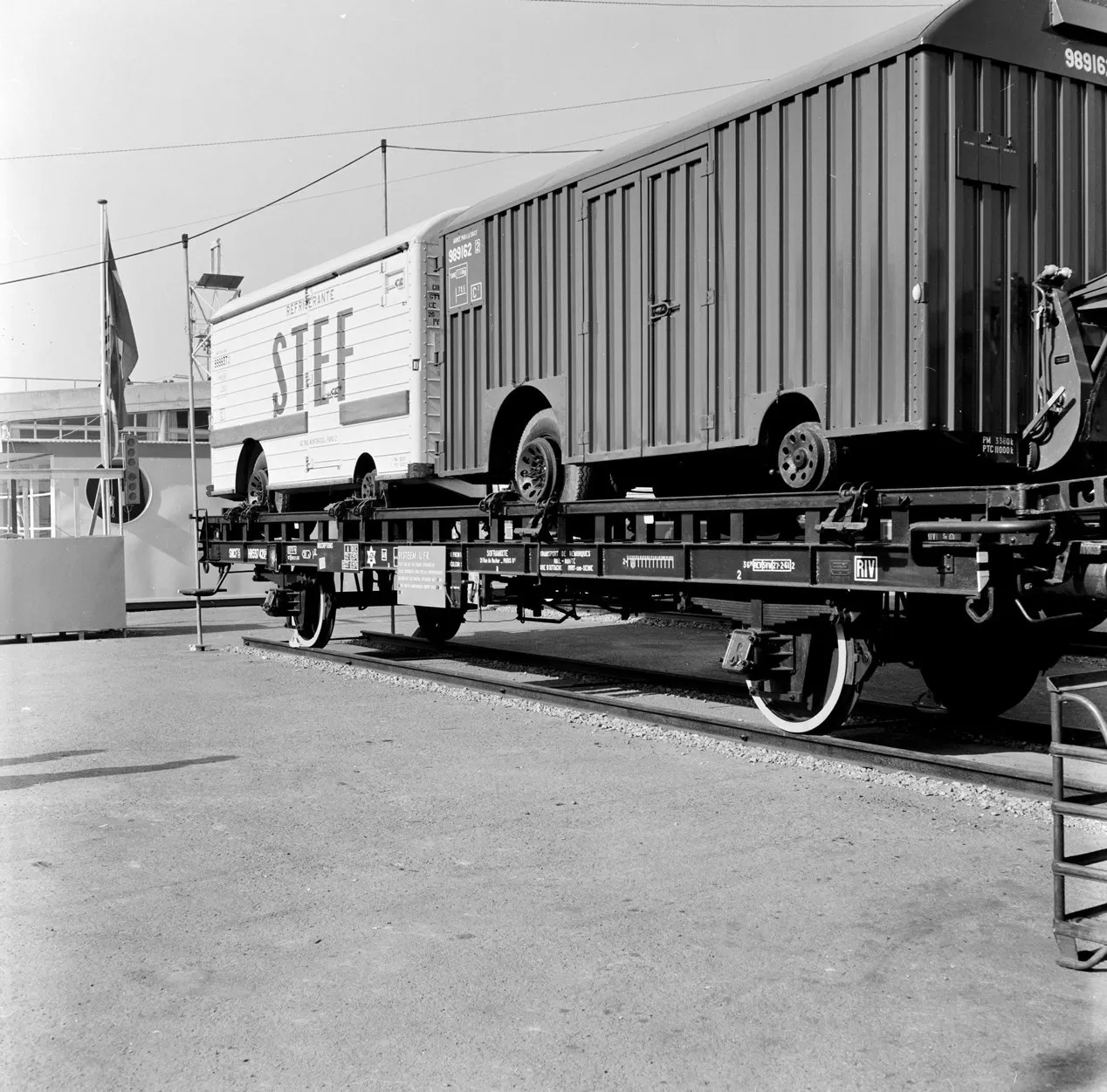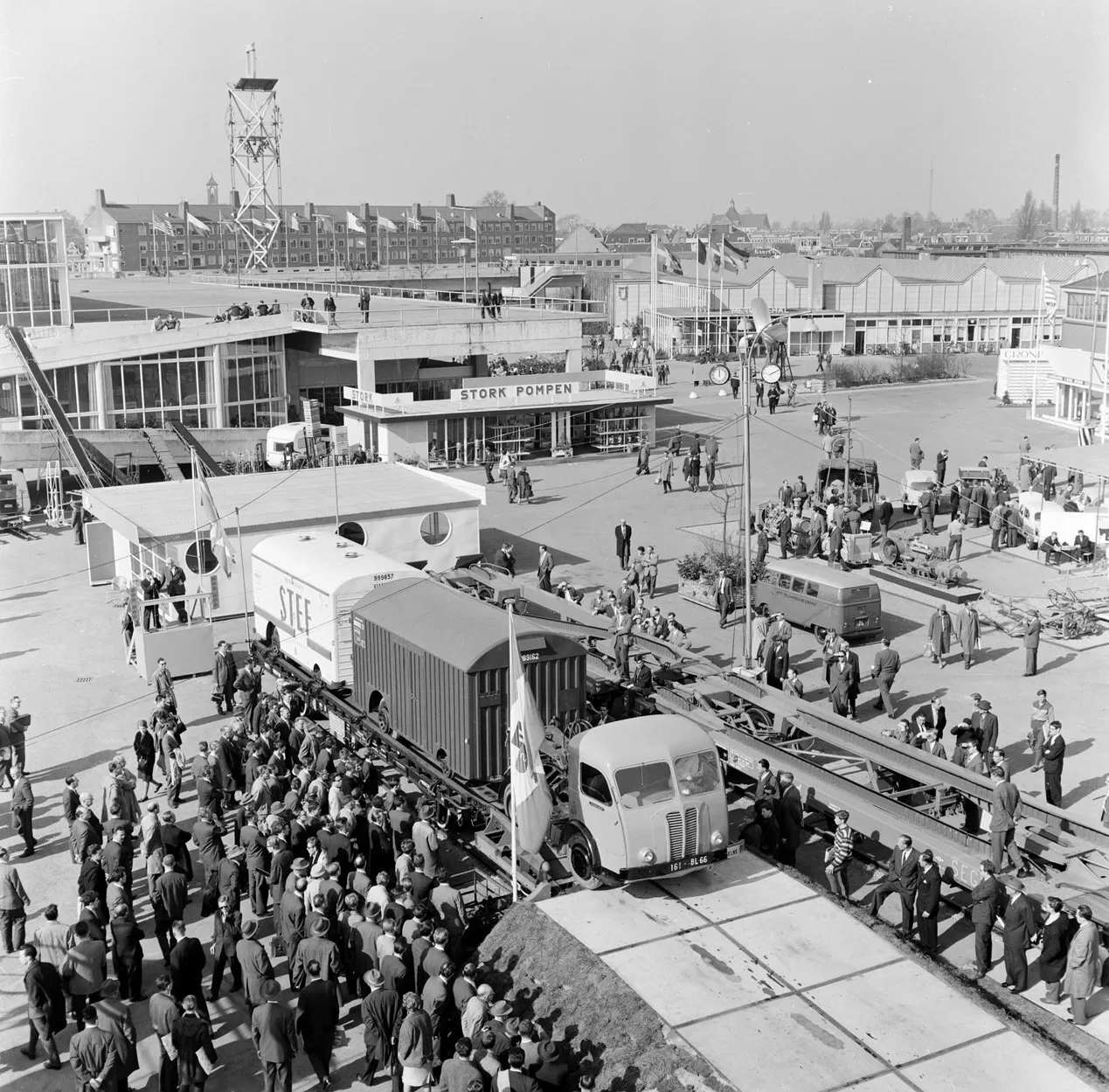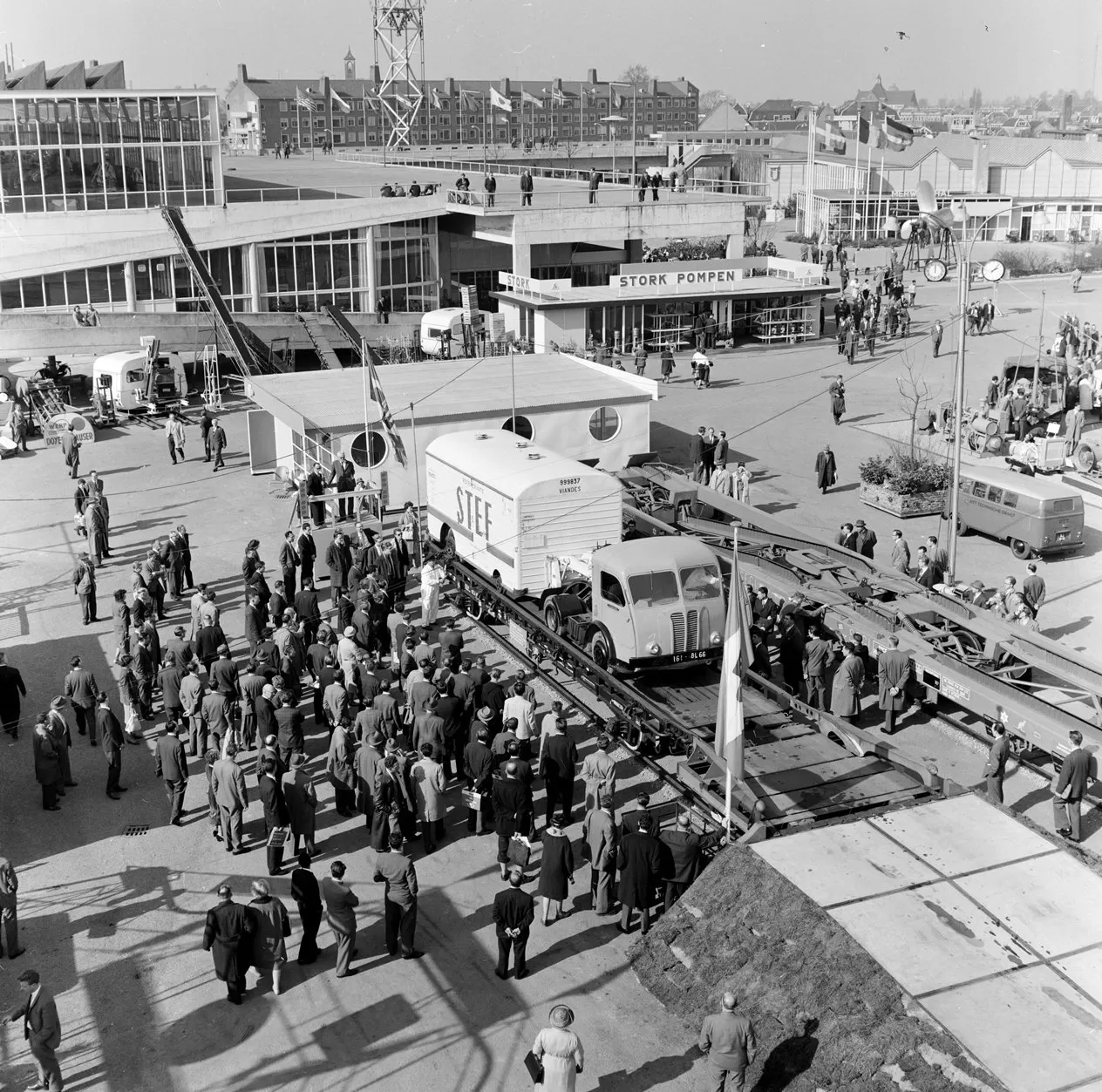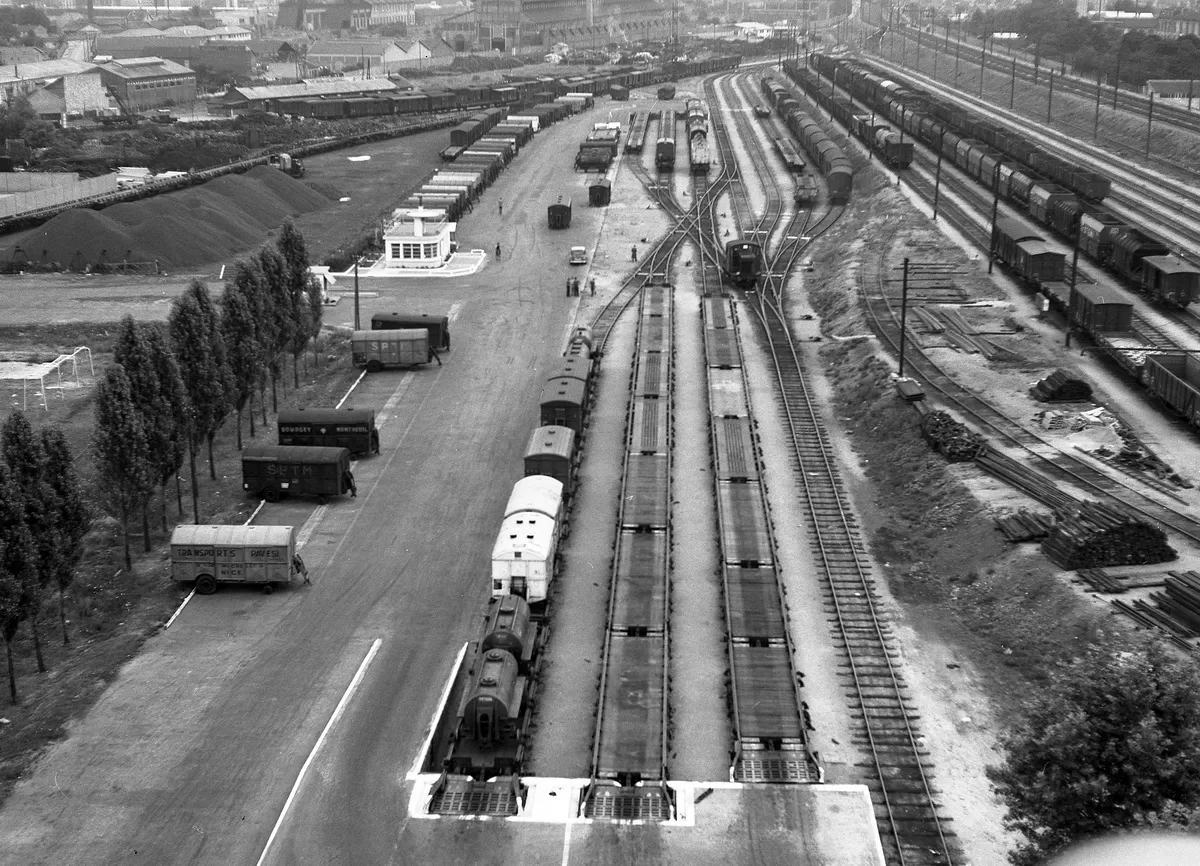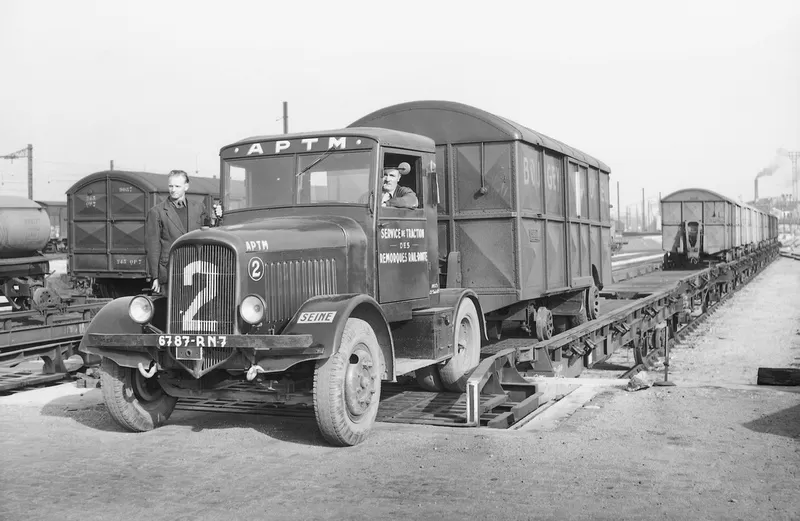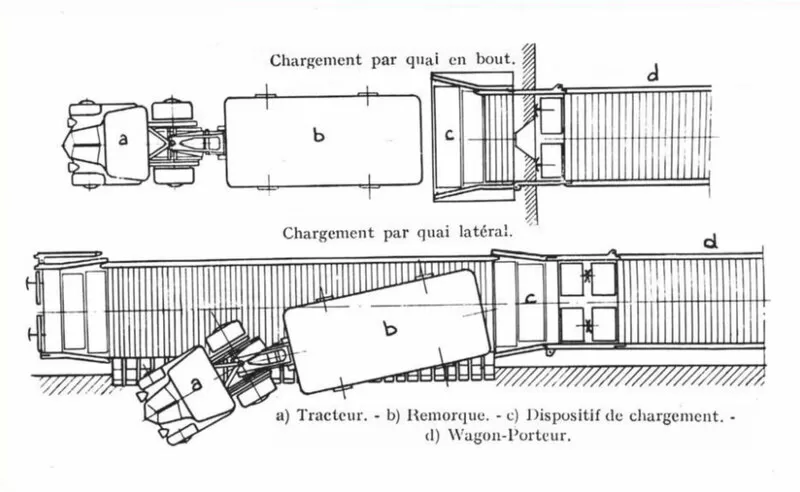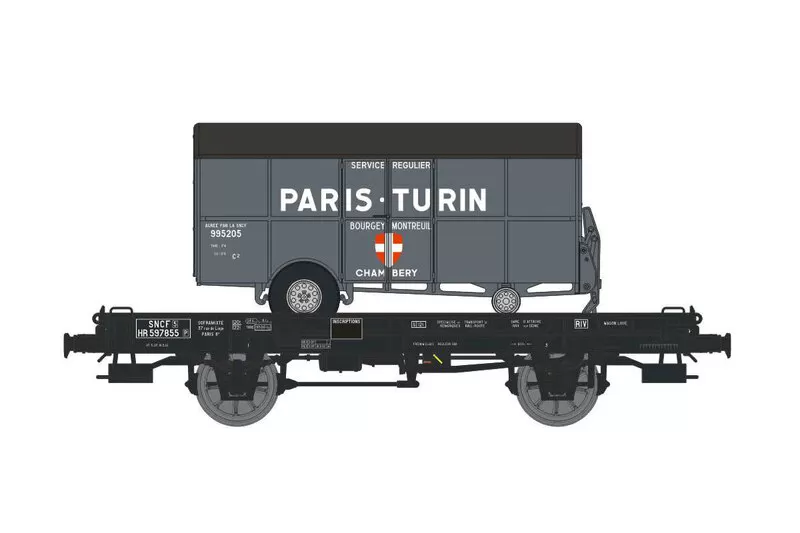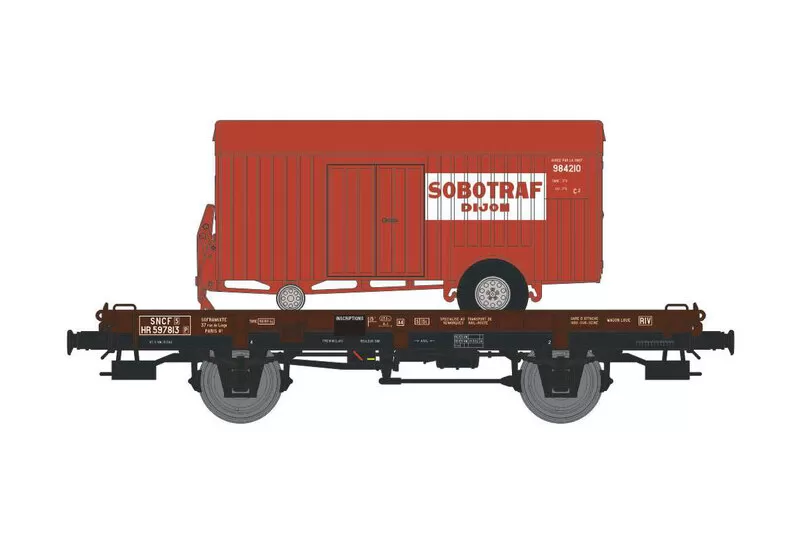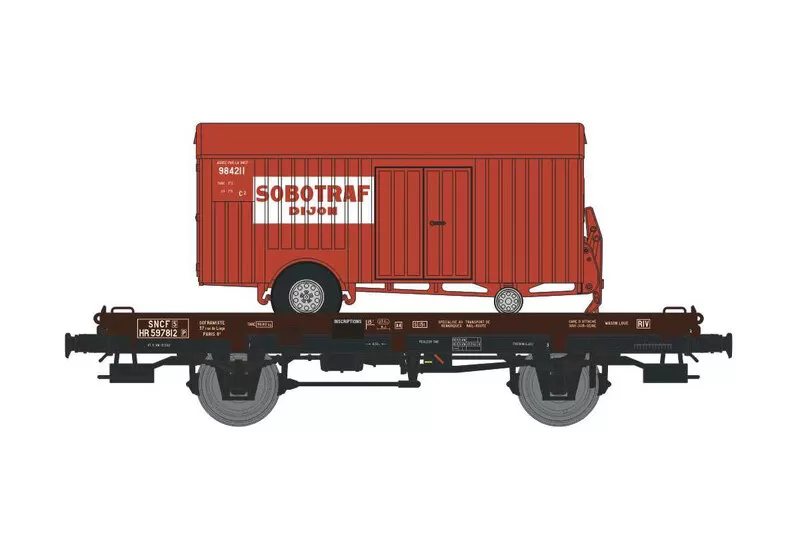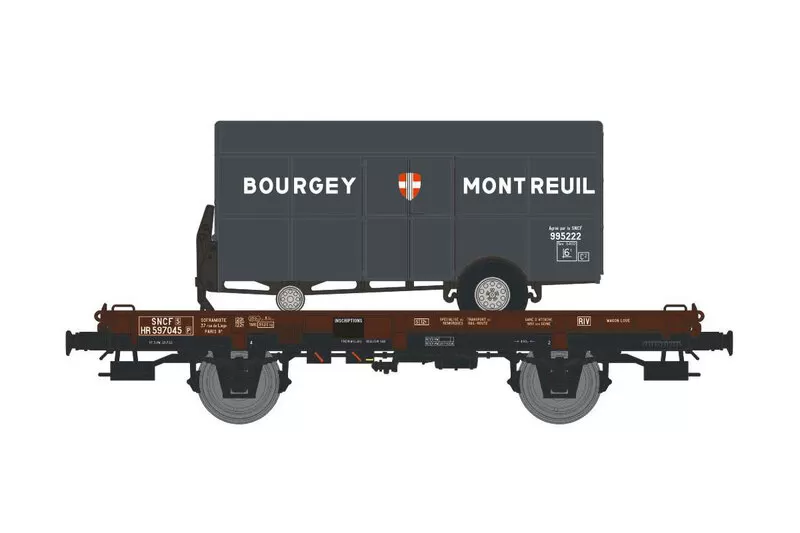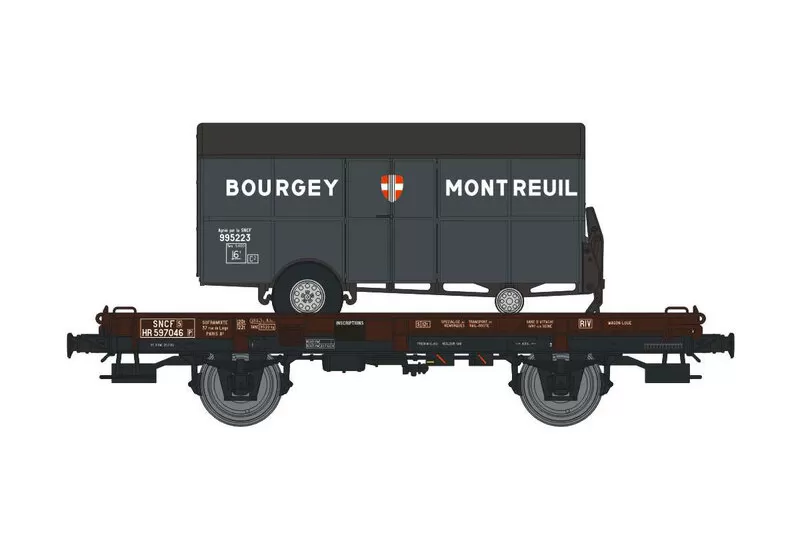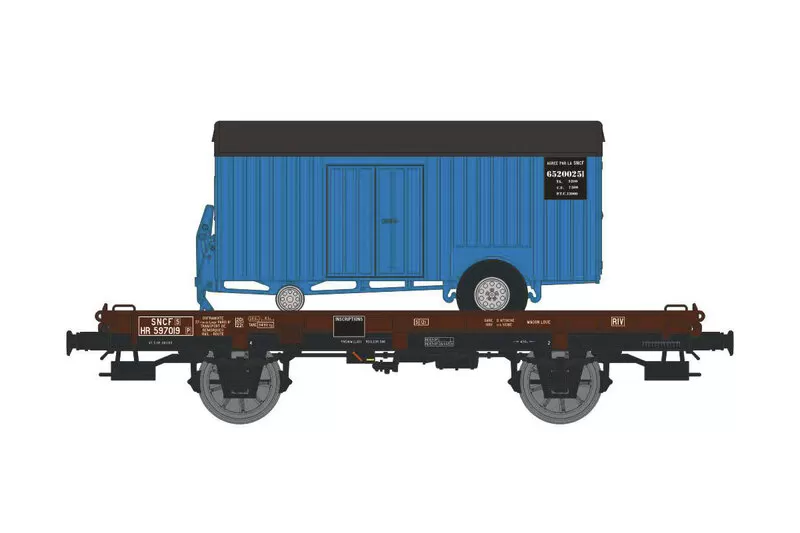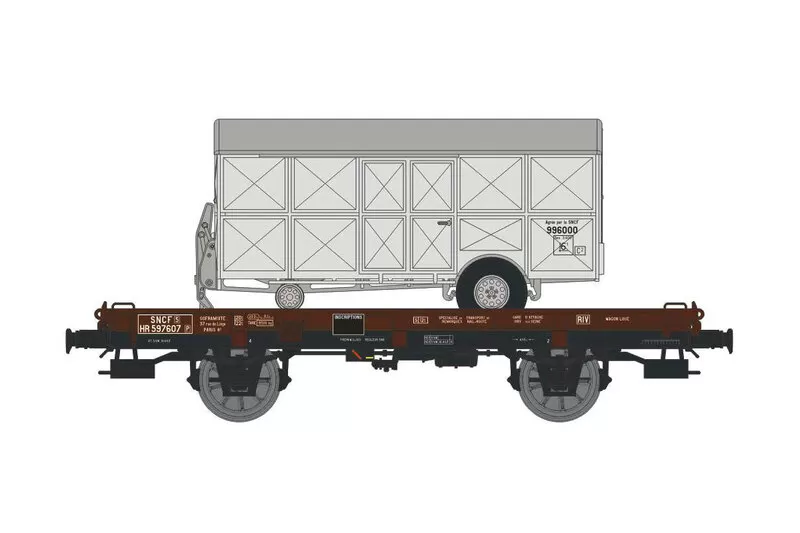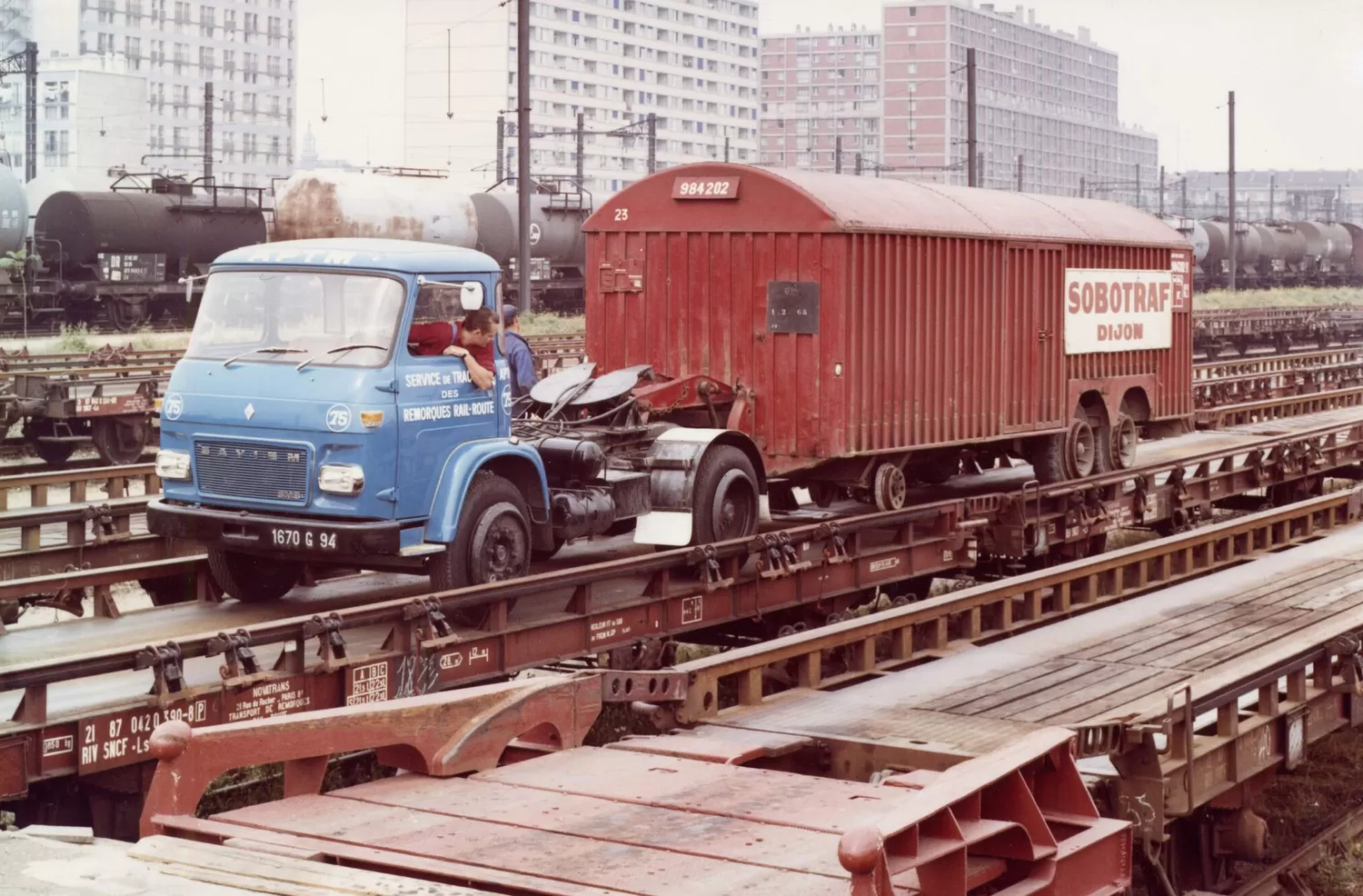
Source: docrail.fr
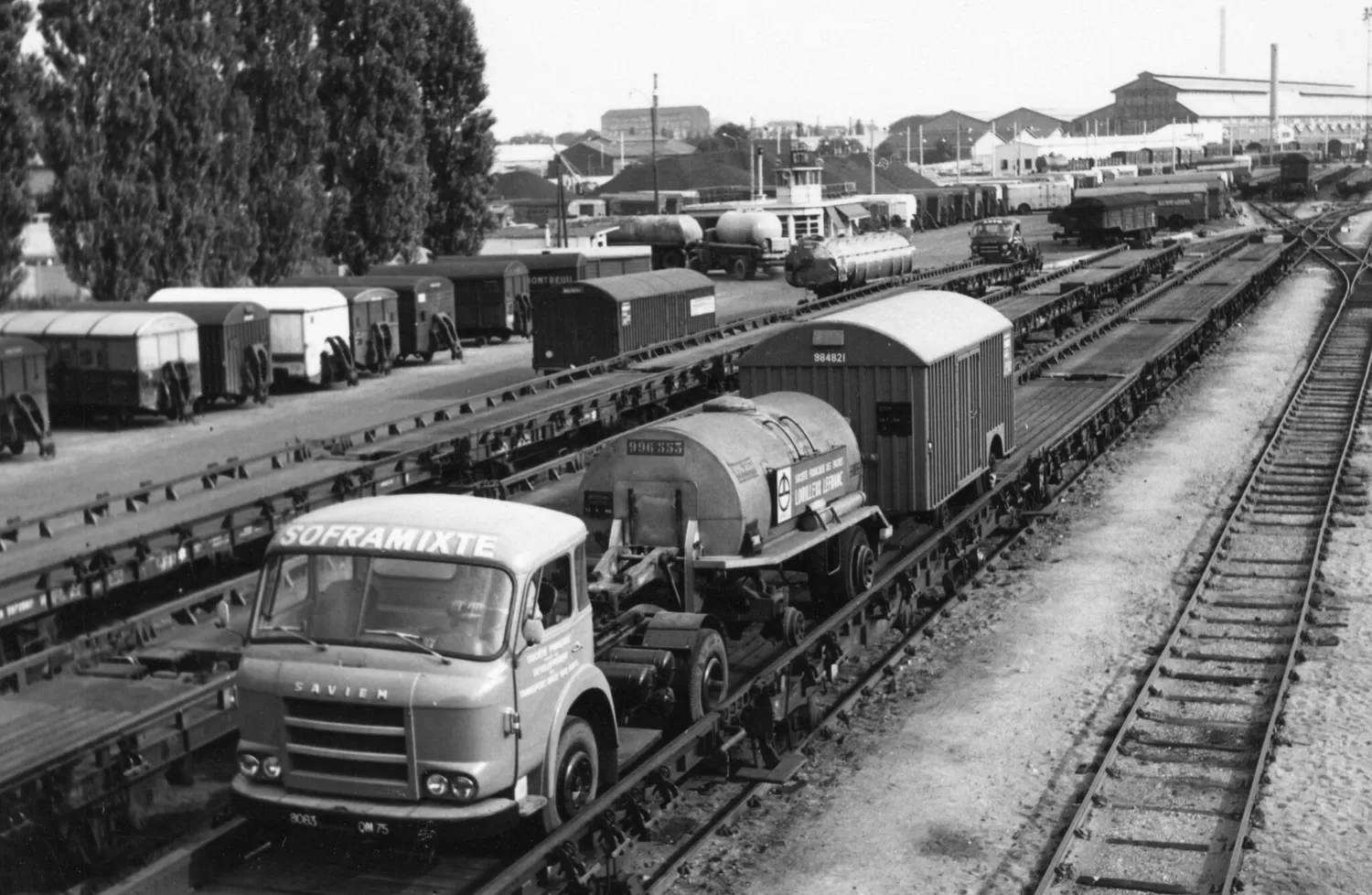
Source: docrail.fr
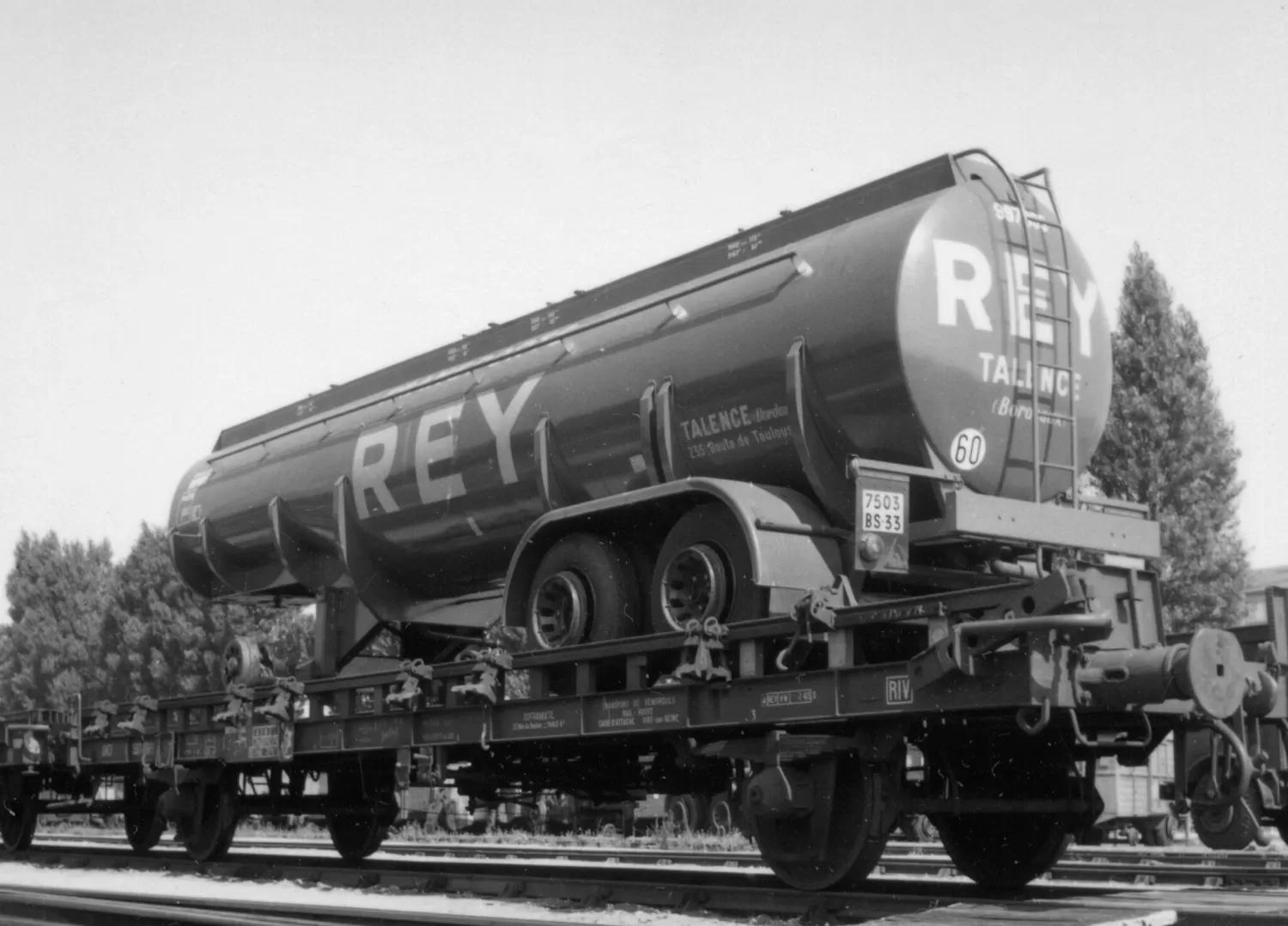
Source: docrail.fr
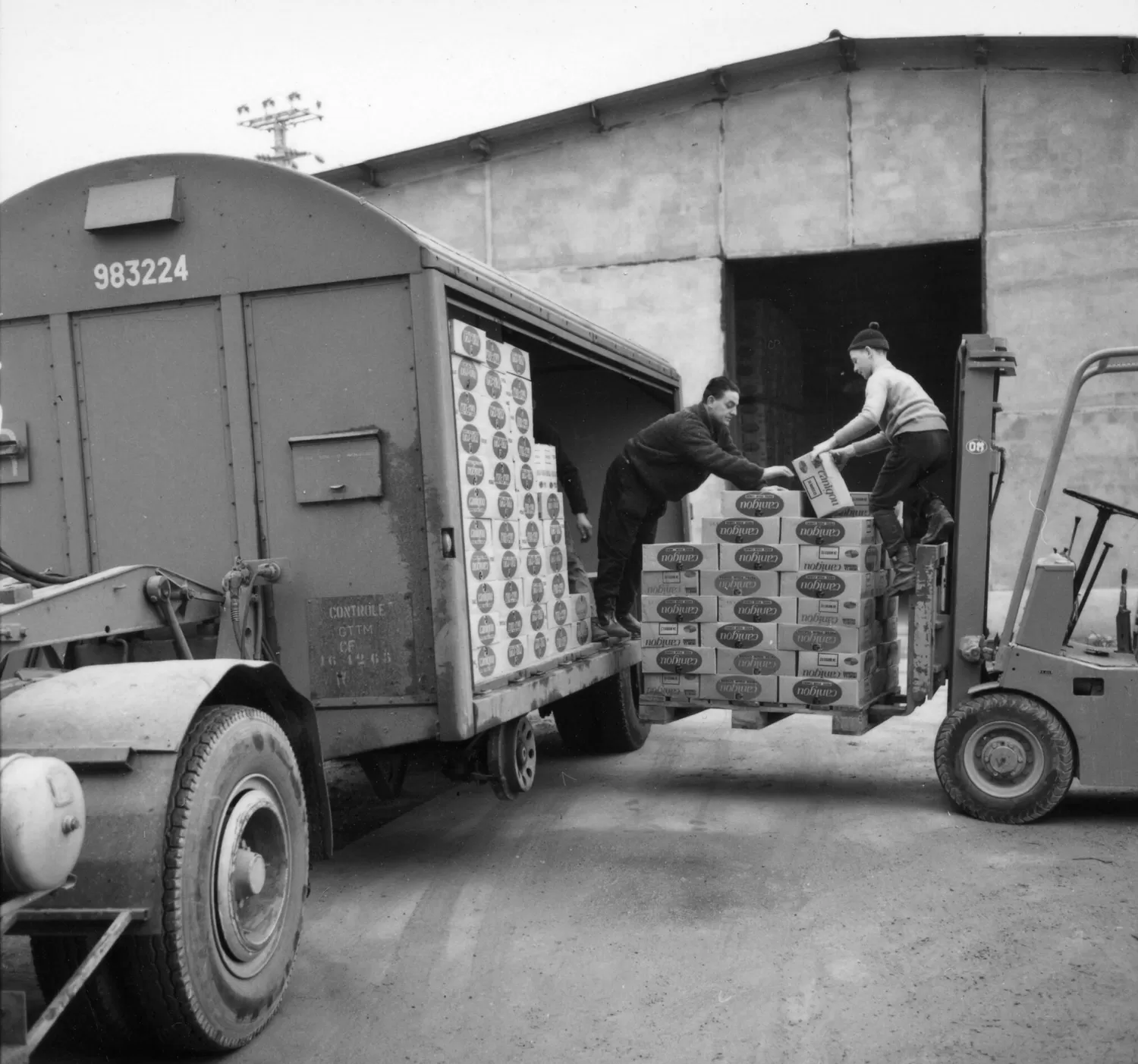
Source: docrail.fr
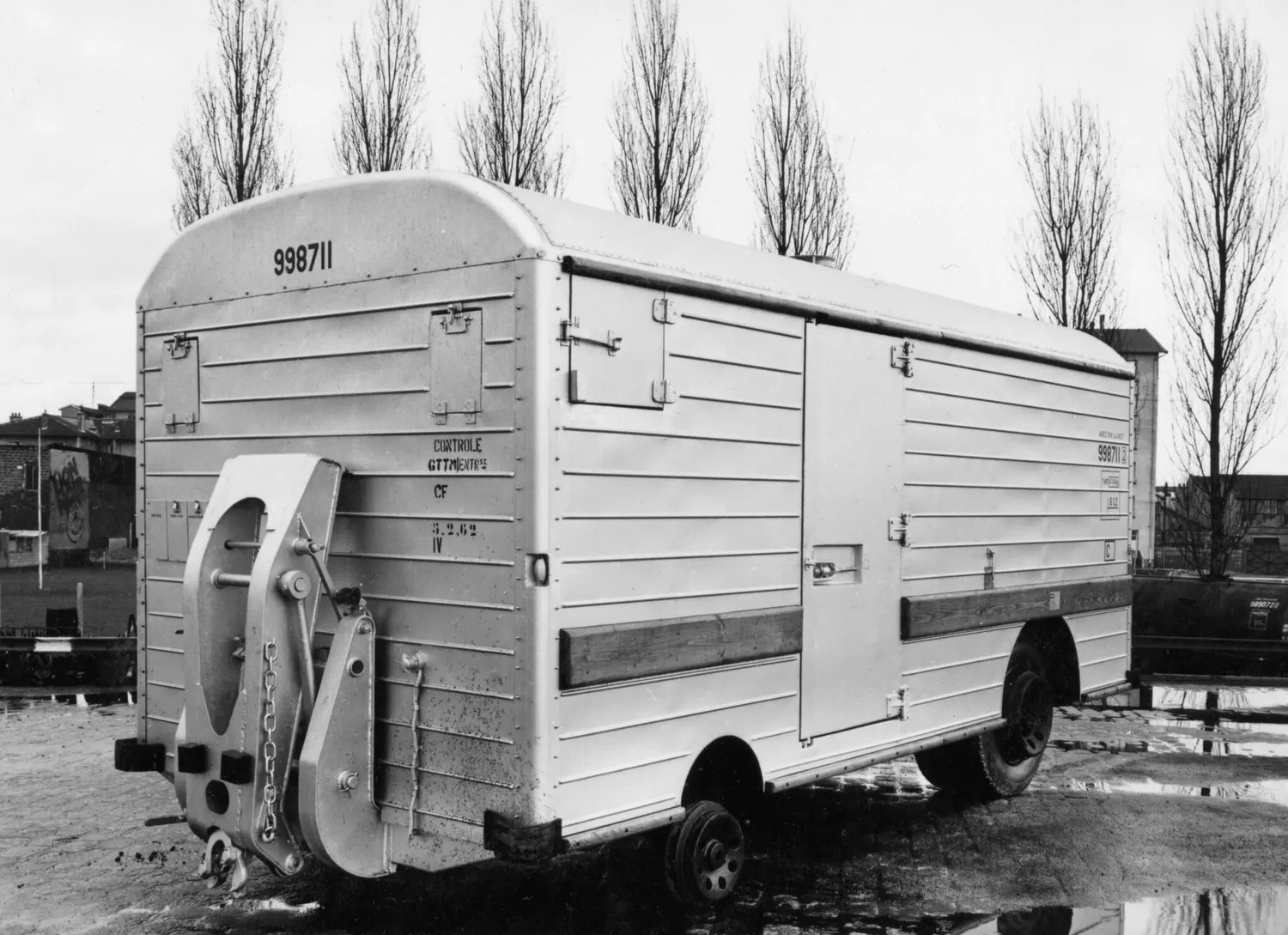
Source: docrail.fr
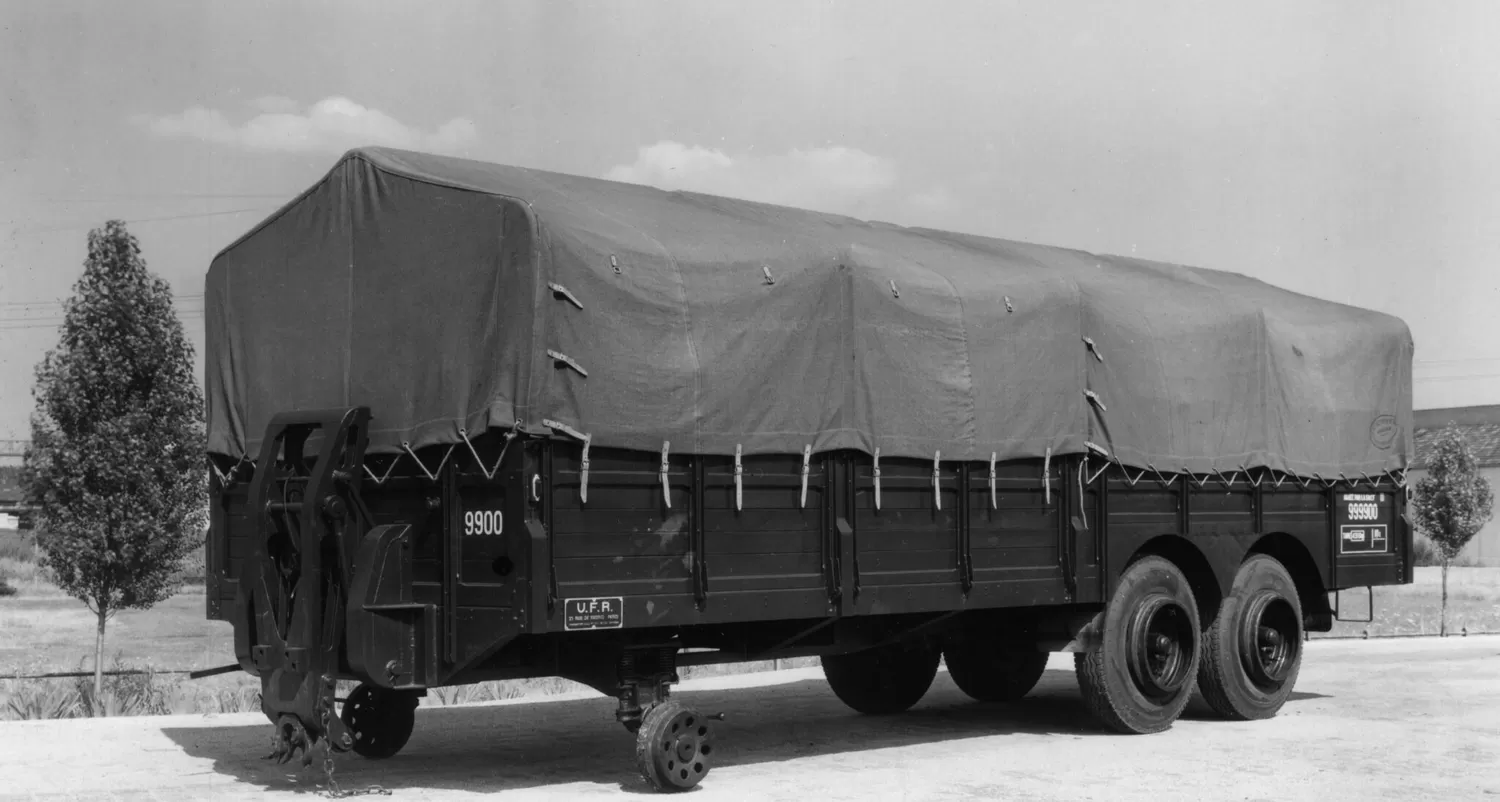
Source: docrail.fr
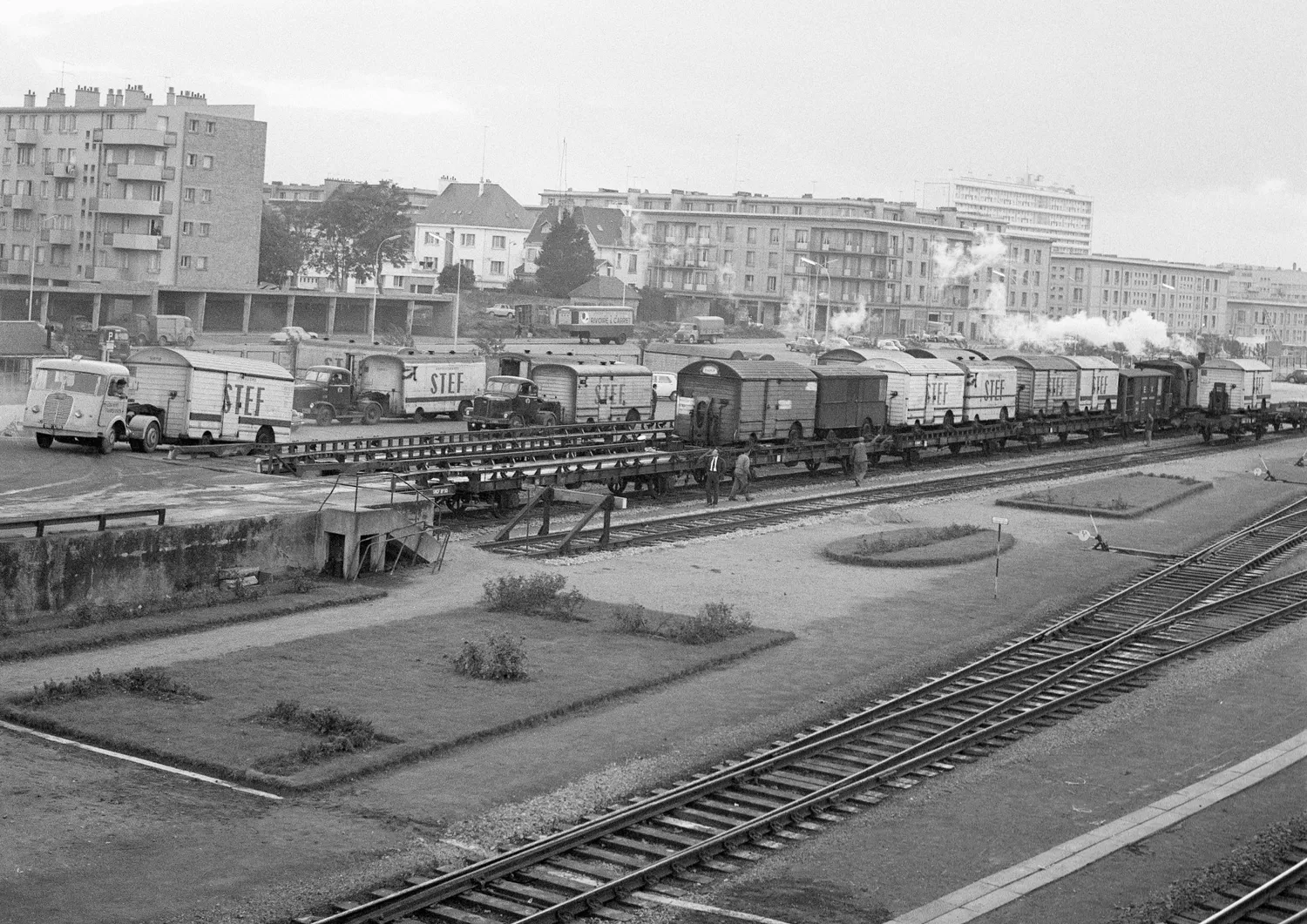
Source: docrail.fr

Source: docrail.fr
UIC / EVN numbering:
21 87 042 021 87 042 120 87 040 0Vehicle type:
Registration country:
Railway companies:
1933
March 14
Filed on December 2nd, 1932, his patent application on "Improvements in means of enabling the transport of rolling loads, in particular vehicles, by railroad cars" is officially registered on March 14th, 1933.
Sources: Les rails de l'histoire n° 4 - https://issuu.com/gayalanouvelleagence/docs/journal_4_site/10
1934
- the French Railway Equipment Company (Compagnie Française de Materiel de Chemins de Fer - CFMCF);
- the Automobile and Commercial Transport Company (Societe des Transports Automobiles et commerciaux - STA);
- the Automobile Transport Industrial Company (Societe Industrielle de Transport Automobile - SITA);
- the Neuflize bank.
President and CEO of the UFR, Rene Porte is working to make his process operational. To do this, his company orders from the private industry 75 wooden road trailers of his design (with a payload of 3.6 t and 6 t) which it leases to carriers. These are road semi-trailers adapted for the rail gauge (reduced height) and are not intended for long haul journeys on the road, they are designed for short distance terminal services. They are fitted with auxiliary rims and a self-folding, balanced drawbar.
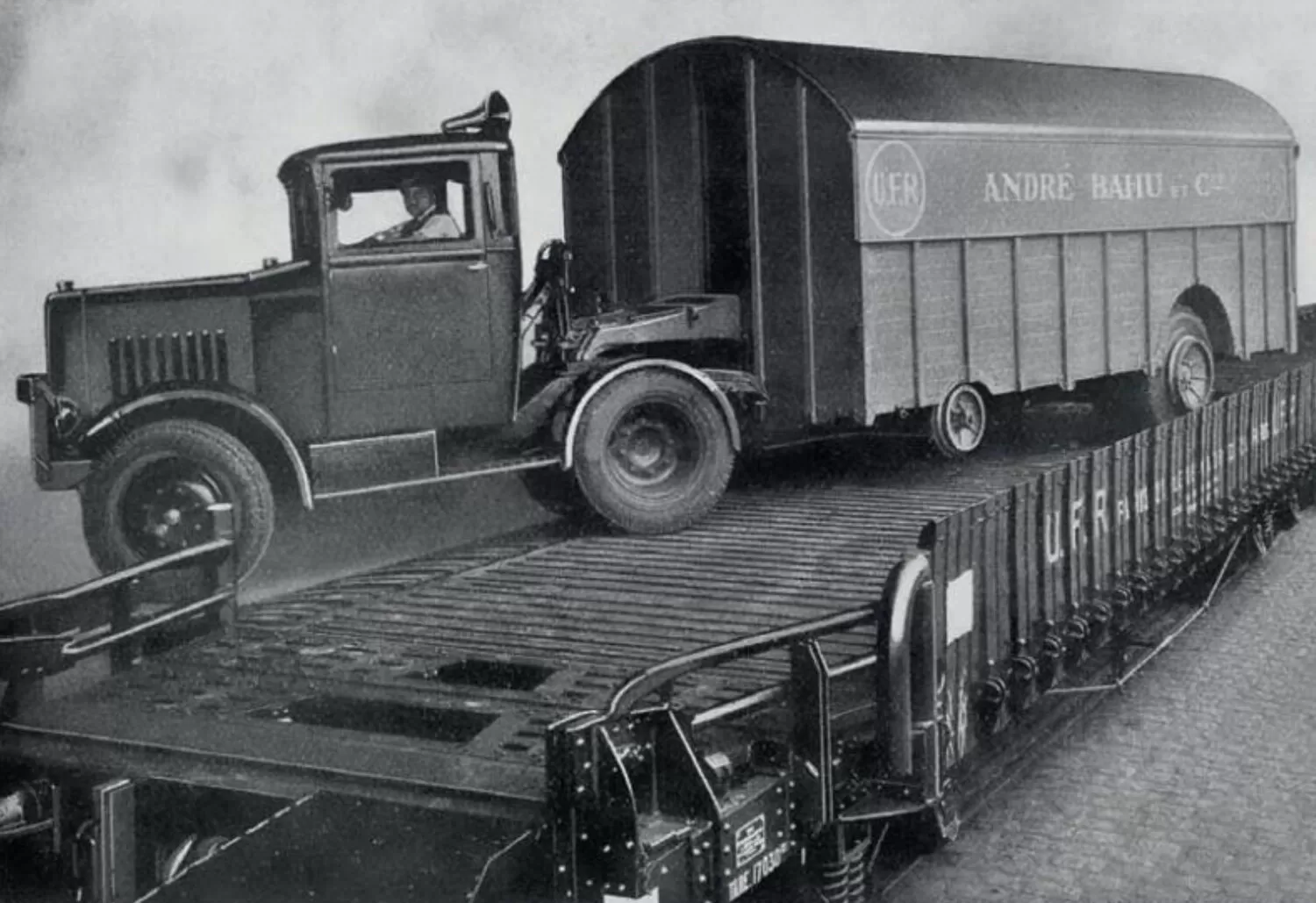
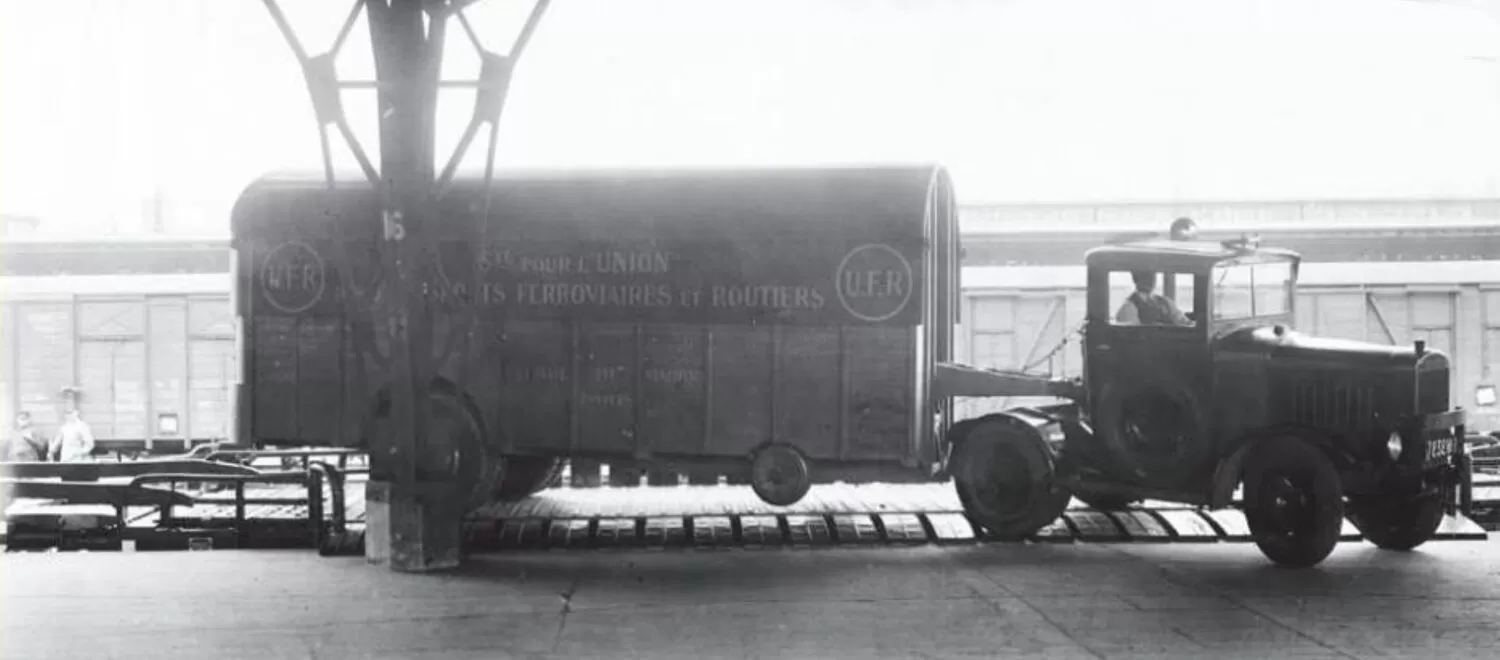
For their transport by rail, he obtains from the railways of the Eastern Railway Company - Est and the State Railways Administration - Ouest-État the "precarious" transfer, for a rent, of 40x bogie wagons which it ensures the transformation into carrier wagons (25x units) and loader wagons* (15x units). 18.5 m over the buffers, the carrier wagons (of the RRlyw type) can accommodate five small trailers (3.4 m long) or three large trailers (5.85 m long). In 1935, the UFR had 5 loader wagons built at its own expense which, placed at the end of the quay, provided an alternative to side loading and unloading. In 1938, it will also draw up the plans for a mobile footbridge allowing to operate directly from the road.
The flat cars are fitted with guide rails in order to center the trailer in the rail gauge. The guide rails support the trailer during rail transport thanks to auxiliary rims.
*With the development of the UFR system and the increase in trailers weight, the use of a loader wagon and side dock will later be limited to single-axle trailers with a total weight not exceeding 11 t. As a result, the most suitable installation for UFR trailers is an end quay fitted with centring guides or equivalent.
Sources: Les rails de l'histoire n° 4 - https://issuu.com/gayalanouvelleagence/docs/journal_4_site/10, https://docrail.fr/le-transport-intermodal/
1935
May 1
- Paris - Bordeaux route managed by the Railways from Paris to Orleans and the Midi - PO-Midi;
- Paris - Lille route managed by the Northern Railway Company - Nord;
- Paris - Lyon route managed by the Railway company from Paris to Lyon and to the Mediterranean - PLM;
- Paris - Strasbourg managed by the Eastern Railway Company - Est and the Alsace and Lorraine railways administration - AL.
The initial schedule is at the rate of a departure every two days soon followed by a daily departure two weeks later. The trip takes 24 hours, for example:
- departure from Paris-Bercy at 23:29 (day 1), arrival at Lyon-Guillotière at 23:49 (day 2);
- departure from Lyon-Guillotière at 4:55 (day 1), arrival at Paris-Bercy at 6:15 (day 2).
The traffic is still limited for each shipment to a wagon loaded with three trailers. The pricing applied by the networks is inspired by the "wagon-kilometre rate" which came into effect in March 1933: the rental and transport of the wagon are invoiced between 2 francs and 4 francs per kilometre, whatever the nature and weight of the load.
Considering that the road transporters work during the day, the trailers are taken in the morning at the station by tractors for the distribution of their content. They are then brought back to the station in the evening after collecting the new load. For loading and unloading at the station, in addition to the constraints related to the FAR coupling, the road tractor used must have a width limited to 2.20m and have its rims fitted with discs intended for centering between the guide rails of the wagons.
Sources: Les rails de l'histoire n° 4 - https://issuu.com/gayalanouvelleagence/docs/journal_4_site/10, https://docrail.fr/le-transport-intermodal/
1935
June 27
- the "amphibious" Willeme-Coder wagon, designed to be able to circulate on both road and rail, tested by the Northern Railway Company - Nord since 1933;
- the wagon carrier trailer developed in Germany by Johann Culemeyer with the support of the German railways, the Deutsche Reichsbahn - DRG.
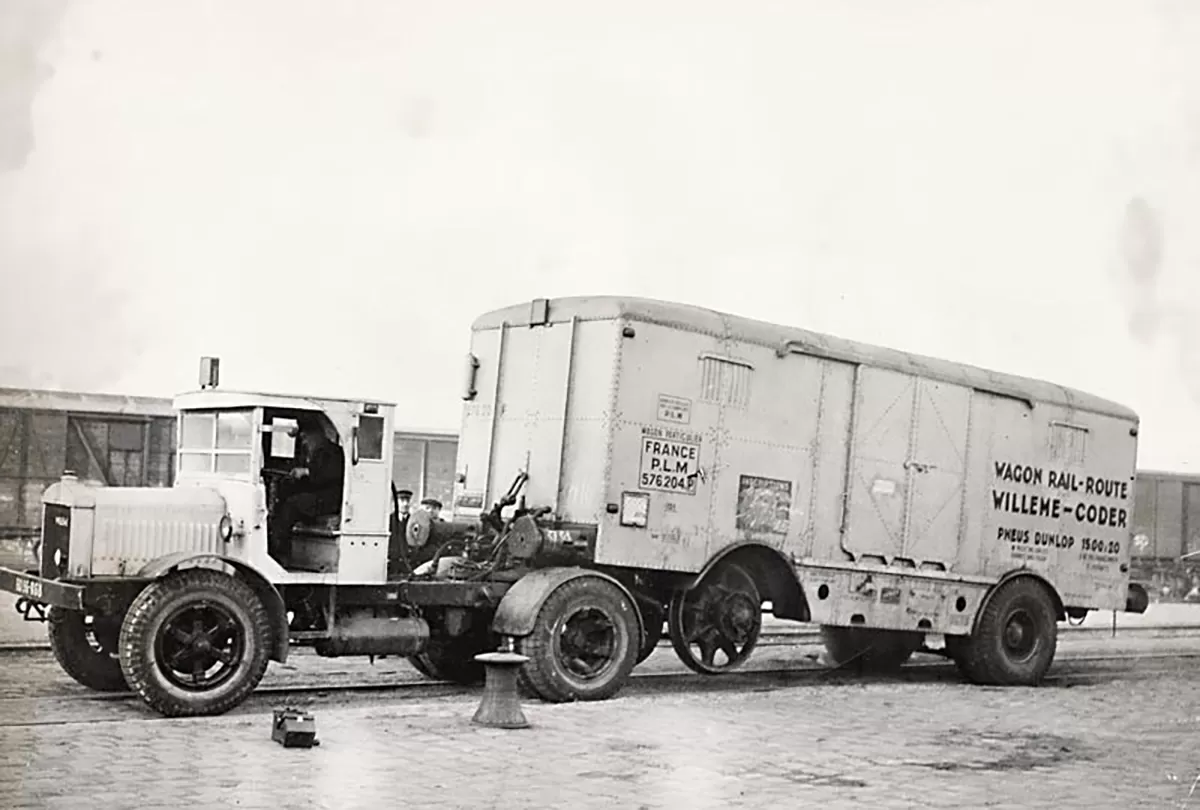
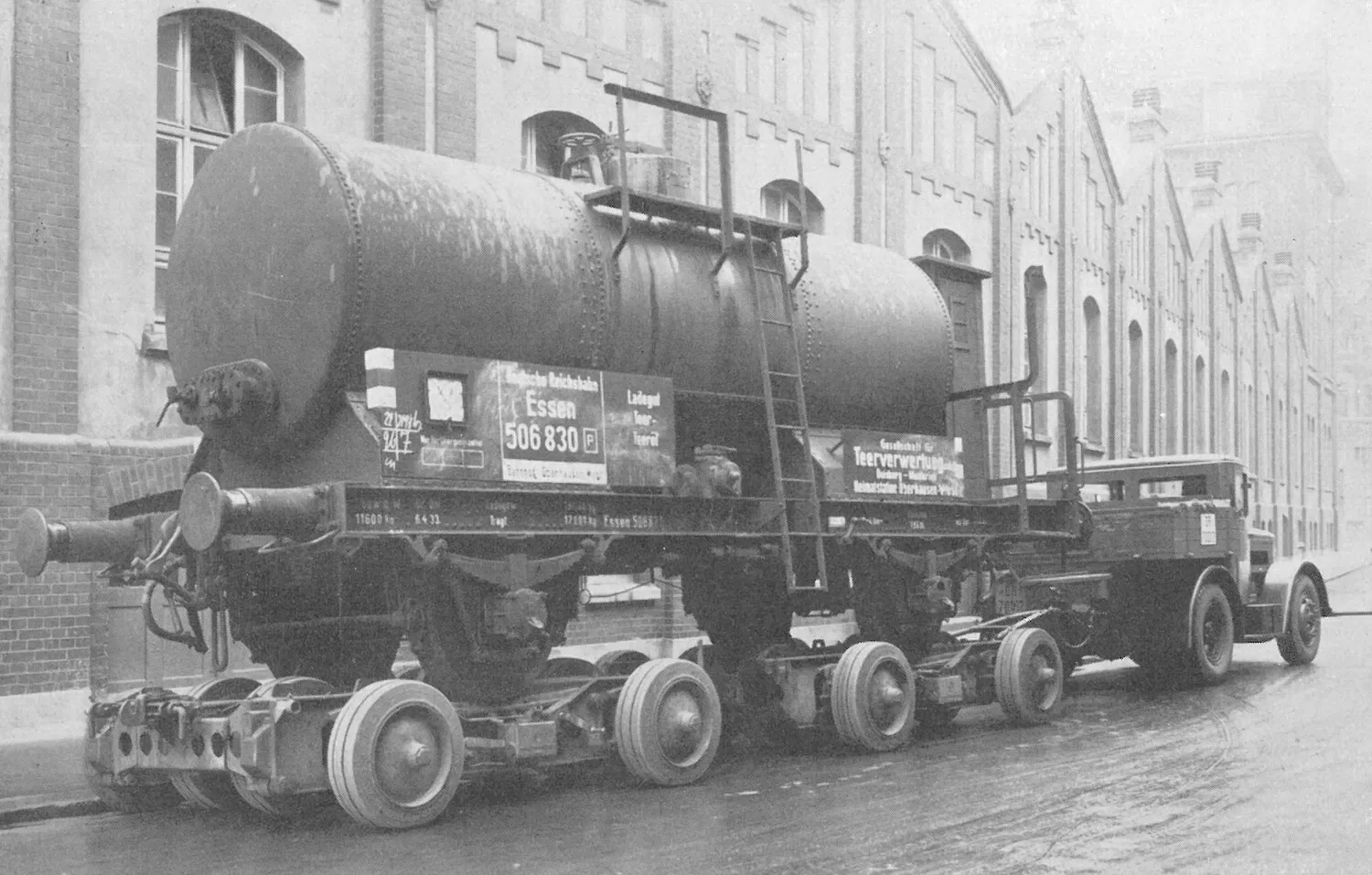
Sources: Les rails de l'histoire n° 4 - https://issuu.com/gayalanouvelleagence/docs/journal_4_site/10, https://docrail.fr/le-transport-intermodal/
1937
November 17
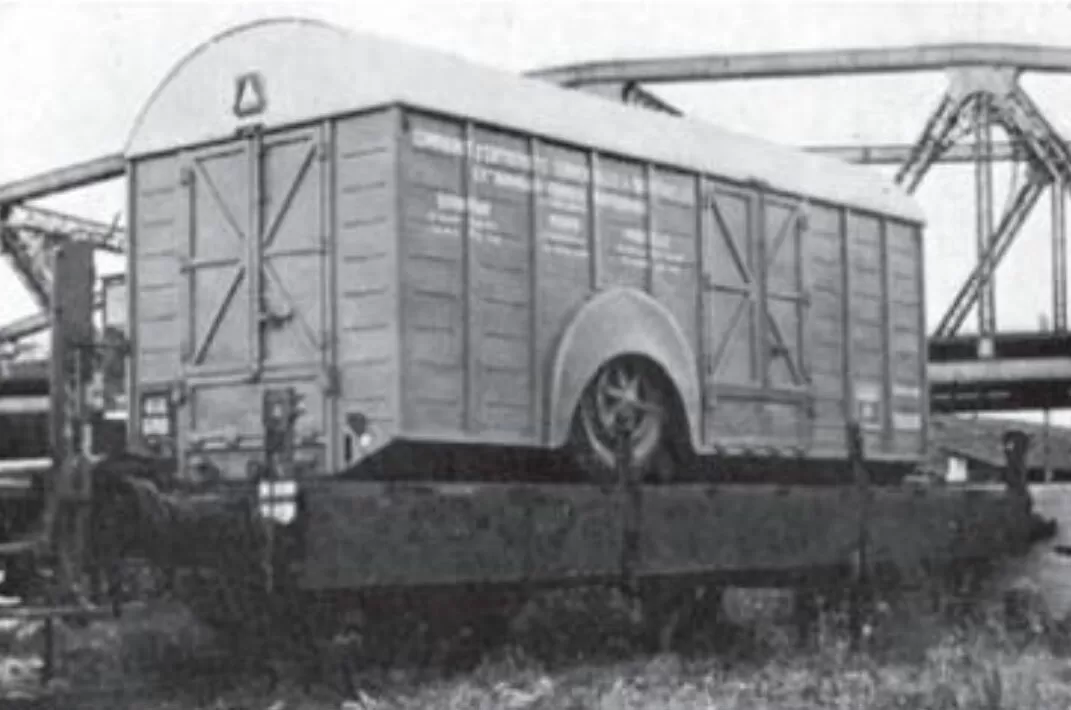 Other
trailer prototypes will subsequently attempt to compete with the
UFR system.
Other
trailer prototypes will subsequently attempt to compete with the
UFR system.But only the one developed by the Company for Studies and Mechanical Achievements (Societe d'Etudes et de REalisations Mécaniques - SEREM) will really hold the attention: a trailer whose body, after retraction of the rear wheelset, comes to rest directly on the floor of the wagon, thus resolving the wedging problem while increasing the trailer height.
SEREM, which filed its patent on November 17th, 1937, joined forces with the CODER establishments of Marseille-Saint-Marcel for the construction of the SEREM - CODER trailers and freight wagons.
Sources: Les rails de l'histoire n° 4 - https://issuu.com/gayalanouvelleagence/docs/journal_4_site/10, https://docrail.fr/le-transport-intermodal/
1938
In 1939, "in order to obtain a deflation of long-distance road transport", the SNCF reflected on the means of organizing mixed transport services by rail and by road. The use of UFR trailers is retained as the most suitable means for this purpose. But it is unthinkable to let UFR master the market. SNCF's position is clear: it will itself provide the trailers and wagons suitable for road companies who request them.
Approached, Rene Porte, ready to collaborate, transmits his conditions on August 10th, 1939. He agrees to return to the SNCF, as is, the 40x wagons given for hire and the 5x loading wagons built by the UFR for 1.030.000 francs. This sum, which represents barely two-thirds of the costs incurred by the UFR since 1935 for the fitting out and the construction of these materials, breaks down as follows:
- 640.000 francs for compensation for the 15x loading wagons (at a unit price of 36 000 francs) and 5 loader wagons (at a unit price of 20,000 francs);
- 150.000 francs for compensation for the 25x carrier wagons (at a unit price of 6,000 francs);
- 240,000 francs for carrier wagons that SNCF deems fit to equip in the future (at a unit price of 6.000 francs per wagon of three trailers, 4.000 francs per wagon of two trailers and 2.000 francs per wagon of three trailers).
Once the amount of 1.030.000 francs is paid, SNCF would be entirely free to fit out new wagons and operate them as it saw fit without having to pay any other fees to UFR.
SNCF accepts Rene Porte's proposal. But if the agreement settled the fate of the wagons, the 75 road trailers remained the property of the UFR. This time setting aside any idea of repurchase, SNCF decided to acquire on its own funds 300 trailers with the aim of reselling them on credit to interested road companies in order to obtain better financial conditions from manufacturers by grouping orders. To this end, the Board of Directors approved, in its meeting of December 4th, 1940, the opening of two credits, one of 30 million francs for the construction of 300 UFR type trailers, the other of 6 million to equip additional wagons.
Sources: Les rails de l'histoire n° 4 - https://issuu.com/gayalanouvelleagence/docs/journal_4_site/10, https://docrail.fr/le-transport-intermodal/
1941
March 4
Sources: Les rails de l'histoire n° 4 - https://issuu.com/gayalanouvelleagence/docs/journal_4_site/10, https://docrail.fr/le-transport-intermodal/
1941
June 20
The French National Railway Company - SNCF protests and assures that it has established its conviction on the technical superiority of UFR trailers based on long experience and numerous adaptations to increase their solidity, which their rivals, in operation only since 1938, cannot take advantage of.
A compromise is found and the French National Railway Company - SNCF agrees to acquire 50 trailers for the SEREM - CODER system which roughly corresponds to the proportion of road carriers interested in this system
The decision is confirmed by the ministerial authorisation on June 20th, 1941 for the order of 250x UFR trailers and 50x SEREM - CODER trailers.
Sources: Les rails de l'histoire n° 4 - https://issuu.com/gayalanouvelleagence/docs/journal_4_site/10, https://docrail.fr/le-transport-intermodal/
1941
July 9
In the case of the UFR system, the best proposal comes from the UFR company and a contract is signed on July 9th, 1941, for 170x metal trailers with a fixed roof, 36x metal trailers with an opening roof (both with a payload of 6 t) and 44x tanks for wine transport (with a capacity of 6.200 l).
Not having its own workshops, the UFR divides the construction of its trailers between four builders:
- the General Company for Construction and Maintenance of Railroad Material in Villefranche-sur-Saone for 100 fixed-roof vans;
- the Lagache and Glatzmann Establishments in Argenteuil for 106 van chassis and 44 tank chassis;
- the Million-Guiet Establishments in Levallois-Perret for 70x fixed-roof vans bodies and 70x open-roof vans bodies;
- the Digard d'Aubervilliers Establishments and Pinchard-Denis de Noisy-le-Sec Establishments for 44x tanks.
The trailers ordered are primarily intended for road carriers who have agreed to abandon part of their long-distance services in favour of rail transport. During the war, thirteen companies signed agreements to this effect: in exchange for handing over a quota of goods to rail transport, they are guaranteed to receive a certain number of these new trailers (either the UFR system or the SEREM - CODER system to choose from) in full ownership (the financing is covered for about 30% by the road companies and for 70% by the French National Railway Company - SNCF) and the insurance of having the platforms and wagons necessary for their loading / unloading and their transport. Amendments are subsequently made to take into account possible obstacles to movement by rail and destruction of equipment attributable to acts of war.
The first to sign is the Northern Automobile Transport Company (Société des Transports Automobiles du Nord - STAN), based in Pierrefitte (Seine), owner of 27 trucks and 10 road trailers representing a tonnage of 290 t and transport licences giving it the right to provide on-demand services throughout France, a status which it is ready to renounce against the promise of receiving 60x UFR trailers. Concluded in early 1941, the agreement is ratified by the Secretary of State for Communications on June 20th: by handing over 40x UFR trailers (75.7% funded by the French National Railway Company - SNCF), STAN undertakes to hand over to the French National Railway Company - SNCF at least 144,5 t of goods per trailer and per semester to be transported from Paris to Lille, Nancy, Rouen, Le Havre, Ponts-et-Marais (Lower Seine) and vice versa. In the event of non-compliance with the contract, SNCF is entitled to take back the trailers.
Among the other signatory companies, we can cite the Bourgey & Montreuil de Charnbery Company (agreement approved on September 22nd, 1941) which, with 13 open-top vans and 17 one-compartment tanks, has undertaken to provide a minimum traffic of 160 t (per semester and per trailer) between Chambery, Lyon, Marseille and Paris and between Chambery and the wine centers of the South of France.
Sources: Les rails de l'histoire n° 4 - https://issuu.com/gayalanouvelleagence/docs/journal_4_site/10
1942
December 30
The State Secretariat for Communications gives its approval on December 30th, 1942, for the acquisition of 15x new loader wagons.
Sources: Les rails de l'histoire n° 4 - https://issuu.com/gayalanouvelleagence/docs/journal_4_site/10
1945
As of December 31st, 1945, only 163x UFR-type trailers are in service.
But the French National Railway Company - SNCF anticipates an increase in demand after the war and even if the 1941 order is not completely delivered they do not hesitate to order 350x additional road trailers in the summer of 1945 and 200x carrier wagons in the winter if 1945. With two axles, 12 m long and able to accommodate two trailers of 10 t each, these wagons are intended to be included in the composition of fast trains and able to pass through gravity yards.
Confirmed in 1946, the new order is split between the UFR system (320x trailers, 175x wagons) and the CEREM-CODER system (30x trailers and 25x wagons).
The UFR materials will actually be delivered:
- between 1947 and 1949 for the trailers;
- in 1948 for the wagons.
Sources: Les rails de l'histoire n° 4 - https://issuu.com/gayalanouvelleagence/docs/journal_4_site/10
1945
October 1
Sources: Les rails de l'histoire n° 4 - https://issuu.com/gayalanouvelleagence/docs/journal_4_site/10
1946
At this date, only seven stations had specific loading-unloading sites: Paris-La Villette, Nancy, Chaumont, Paris-La Chapelle, Lille-Saint-Sauveur, Paris-Batignolles and Le Havre.
The same year, as the new carrier wagons ordered in 1945 are not yet delivered (they will be delivered in 1948) and in order to deal with the pressing needs, the French National Railway Company - SNCF proceeds to the transformation of 200x flat units from its own fleet:
- 100x single carriers wagons registered 430000, 429501 - 429557 & 429958 - 429999 transformed from previous OCEM 29 freight wagons delivered to the Railway company from Paris to Lyon and to the Mediterranean - PLM and the Southern Railway Company - Midi between 1931 and 1934;
- 100x double carriers wagons registered 425801 - 425900 transformed from previous RRuw freight wagons delivered to the Eastern Railway Company - Est and NNuw freight wagons delivered to the Alsace and Lorraine railways administration - AL in 1931.
Sources: Les rails de l'histoire n° 4 - https://issuu.com/gayalanouvelleagence/docs/journal_4_site/10, Correspondances n° 16 (12.2004 - 01.2005)
1947
This association governed by the 1901 law brings together around their founding president Rene Mazeaud (1911-1986) consolidators, commission agents and road carriers. Its local branches play a role both commercially (relationship with customers) and technically (reception of trailers and wagons, monitoring and maintenance).
Sources: Les rails de l'histoire n° 4 - https://issuu.com/gayalanouvelleagence/docs/journal_4_site/10
1948
August 1
Sources: Les rails de l'histoire n° 4 - https://issuu.com/gayalanouvelleagence/docs/journal_4_site/10
1948
October 5
This ceremony shortly precedes the major “door to door” exhibition held at the Paris-Batignolles station from October 11th to 16th.
Sources: Les rails de l'histoire n° 4 - https://issuu.com/gayalanouvelleagence/docs/journal_4_site/10
1949
NB: Subsequently, SOFRAMIXTE will also manage the UFR wagon fleet set up by SCETA. As it is also responsible for financing the purchase of new equipment, it will be led to own its own UFR wagons.
Sources: Les rails de l'histoire n° 4 - https://issuu.com/gayalanouvelleagence/docs/journal_4_site/10
1949
December 31
*At its peak in the 1960s, there are around 185 stations in France capable of handling UFR trailers. The system also covers the metric gauge (CFD Vivarais) as well as some key points of the German, Belgian, Dutch or Italian networks. The tonnage transported amounts to 890.000 t per year carried by over 2.500 semi-trailers (owned by 165 private companies) and 1,300 wagons (270 single-carrier and 1030 twin-carrier).
Sources: Les rails de l'histoire n° 4 - https://issuu.com/gayalanouvelleagence/docs/journal_4_site/10, https://docrail.fr/le-transport-intermodal/
1967
Sources: Les rails de l'histoire n° 4 - https://issuu.com/gayalanouvelleagence/docs/journal_4_site/10
1968
Sources: Les rails de l'histoire n° 4 - https://issuu.com/gayalanouvelleagence/docs/journal_4_site/10
1983
Sources: Les rails de l'histoire n° 4 - https://issuu.com/gayalanouvelleagence/docs/journal_4_site/10
Do you have additional informations regarding this vehicle?
Help us writing the history of UFR freight wagon! Your knowledge is precious for us and the entire community, do not hesitate to share your facts, photos or videos:
Latest update on the 15th of August 2021 at 21:47
Contributor(s): Tudor C.
Discussion forum

